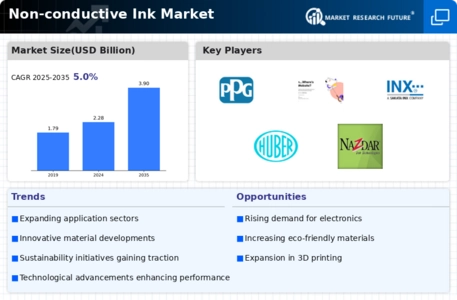Expansion of the Automotive Sector
The automotive industry is undergoing a transformation, with an increasing emphasis on electronic components and smart technologies. This shift is positively influencing the Non-conductive Ink Market, as non-conductive inks are essential for the production of various automotive applications, including sensors and displays. The integration of advanced electronics in vehicles is expected to drive the demand for non-conductive inks, as manufacturers seek to enhance functionality and performance. With the automotive sector projected to grow at a CAGR of 5% over the next few years, the non-conductive ink market is likely to benefit from this expansion, as more automotive manufacturers adopt these innovative materials.
Advancements in Printing Technologies
Technological innovations in printing methods are significantly impacting the Non-conductive Ink Market. The development of advanced printing techniques, such as inkjet and screen printing, allows for more precise application of non-conductive inks. These advancements enable manufacturers to produce intricate designs and patterns that were previously unattainable. Furthermore, the integration of digital printing technologies is streamlining production processes, reducing waste, and enhancing efficiency. As a result, the market for non-conductive inks is expected to grow at a compound annual growth rate (CAGR) of approximately 8% over the next five years, reflecting the increasing reliance on these innovative printing solutions.
Emergence of Smart Packaging Solutions
The rise of smart packaging solutions is significantly shaping the Non-conductive Ink Market. As brands seek to enhance consumer engagement and provide interactive experiences, non-conductive inks are being utilized in the development of smart labels and packaging. These inks enable functionalities such as QR codes, NFC technology, and temperature indicators, which are increasingly popular among consumers. The smart packaging market is anticipated to reach USD 30 billion by 2027, indicating a robust growth trajectory that will likely benefit the non-conductive ink sector. This trend reflects a broader movement towards integrating technology into everyday products, thereby driving innovation and demand within the non-conductive ink market.
Growing Focus on Sustainable Materials
Sustainability is becoming a pivotal factor in the Non-conductive Ink Market. As environmental concerns rise, manufacturers are increasingly seeking eco-friendly alternatives to traditional inks. Non-conductive inks made from renewable resources and non-toxic materials are gaining traction among consumers and businesses alike. This shift towards sustainable materials is not only beneficial for the environment but also aligns with the growing regulatory pressures for greener production practices. The market for sustainable inks is projected to expand significantly, with estimates suggesting a growth rate of around 10% annually. This trend is likely to drive innovation and investment in the non-conductive ink sector, as companies strive to meet consumer demand for environmentally responsible products.
Rising Demand for Flexible Electronics
The Non-conductive Ink Market is experiencing a notable surge in demand for flexible electronics. This trend is driven by the increasing adoption of wearable devices, flexible displays, and smart packaging solutions. As consumers seek more versatile and portable electronic devices, manufacturers are turning to non-conductive inks to create lightweight and flexible circuits. According to recent estimates, the flexible electronics market is projected to reach USD 50 billion by 2026, which directly influences the growth of the non-conductive ink sector. The ability of non-conductive inks to adhere to various substrates while maintaining performance is crucial in meeting the evolving needs of the electronics industry.




















Leave a Comment